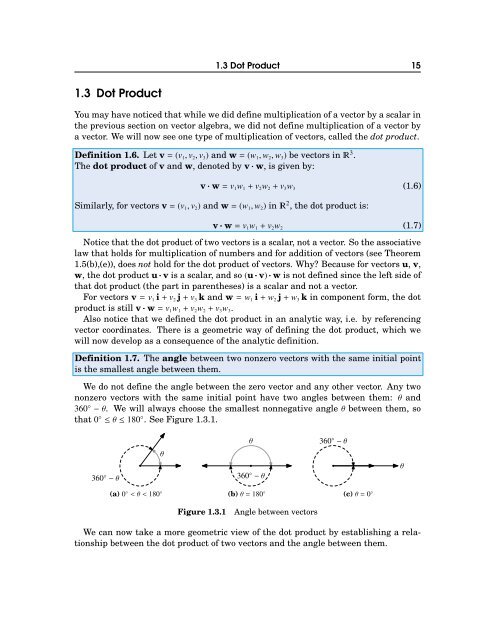Michael Corral: Vector Calculus
Michael Corral: Vector Calculus
Michael Corral: Vector Calculus
You also want an ePaper? Increase the reach of your titles
YUMPU automatically turns print PDFs into web optimized ePapers that Google loves.
1.3 Dot Product 15<br />
1.3 Dot Product<br />
Youmayhavenoticedthatwhilewediddefinemultiplicationofavectorbyascalarin<br />
the previous section on vector algebra, we did not define multiplication of a vector by<br />
a vector. We will now see one type of multiplication of vectors, called the dot product.<br />
Definition 1.6. Let v=(v 1 ,v 2 ,v 3 ) and w=(w 1 ,w 2 ,w 3 ) be vectors in 3 .<br />
The dot product of v and w, denoted by v·w, is given by:<br />
v·w=v 1 w 1 +v 2 w 2 +v 3 w 3 (1.6)<br />
Similarly, for vectors v=(v 1 ,v 2 ) and w=(w 1 ,w 2 ) in 2 , the dot product is:<br />
v·w=v 1 w 1 +v 2 w 2 (1.7)<br />
Noticethatthedotproductoftwovectorsisascalar, notavector. Sotheassociative<br />
law that holds for multiplication of numbers and for addition of vectors (see Theorem<br />
1.5(b),(e)), does not hold for the dot product of vectors. Why? Because for vectors u, v,<br />
w, the dot product u·v is a scalar, and so (u·v)·w is not defined since the left side of<br />
that dot product (the part in parentheses) is a scalar and not a vector.<br />
For vectors v=v 1 i+v 2 j+v 3 k and w=w 1 i+w 2 j+w 3 k in component form, the dot<br />
product is still v·w=v 1 w 1 +v 2 w 2 +v 3 w 3 .<br />
Also notice that we defined the dot product in an analytic way, i.e. by referencing<br />
vector coordinates. There is a geometric way of defining the dot product, which we<br />
will now develop as a consequence of the analytic definition.<br />
Definition 1.7. The angle between two nonzero vectors with the same initial point<br />
is the smallest angle between them.<br />
We do not define the angle between the zero vector and any other vector. Any two<br />
nonzero vectors with the same initial point have two angles between them: θ and<br />
360 ◦ −θ. We will always choose the smallest nonnegative angleθbetween them, so<br />
that 0 ◦ ≤θ≤180 ◦ . See Figure 1.3.1.<br />
θ<br />
θ 360 ◦ −θ<br />
θ<br />
360 ◦ −θ<br />
360 ◦ −θ<br />
Figure 1.3.1 Angle between vectors<br />
(c)θ=0 ◦<br />
We can now take a more geometric view of the dot product by establishing a relationship<br />
between the dot product of two vectors and the angle between them.








